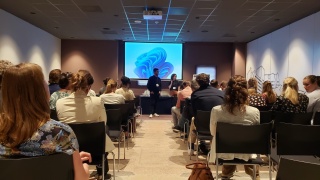Increased well-being through digital intervention?
07-06-2024

Also curious about how to support the improvement of physical and mental health with the use of technology? At the end of May, you could immerse yourself in this theme for two days at the 'Supporting Health by Tech' congress in Groningen. With take-aways including electronic and mobile interventions, smart coaching, deployment of big data, artificial intelligence (AI) and self-tracking.
AI and social good
Marwan el Morabet, lecturer-researcher at Digital Life (DMCI faculty, HvA), was there in Groningen. He provided one of the workshops - with 40 listeners - on how you can design AI solutions together with citizens to increase well-being and social cohesion in a neighborhood. Naturally, ethical implications were also discussed. Marwan made his findings during the two-year research project 'It takes a village to grow old' from SIA-RAAK, in which the Amsterdam University of Applied Sciences was involved as one of the partners.
Citizen participation
'It takes a village to grow old' was carried out as participatory research using the methodology 'Extreme Citizen Science': citizens of Stadsdorp Vondel/Helmers in Amsterdam were 100% deployed as researchers. The 28 people who participated in this project had no AI expertise and spanned diverse age groups, education levels and backgrounds.
The actually 'trained' AUAS researchers functioned more as coaches with this methodology, for example to show AI demos and give inspiration sessions about AI.
Visible results
The citizens' findings, in combination with the expertise of the consortium partners, ultimately led to the design and construction of the physical Neighborhood Stories Bench as well as the digital Neighborhood Stories Wall.
With this digital wall, stories can be generated using AI. Using a drop-down menu, you enter a location, year and subject, after which your neighborhood story will be automatically written by ChatGPT. But local residents can also upload their own story. This web application was built in collaboration with illi-tv.
The results so far? Since the end of February until mid-June (2024), at least 112 people have used this Neighborhood Story Wall. A total of 40 stories were generated, four of which were written by hand (for example one about the Helmersbuurt fire in 2019).
Curious about the digital Neighborhood Story Wall? Take a look for yourself online!
Ethical conditions for AI
Also not unimportant: European guidelines establish a set of seven important -ethical- requirements that AI systems must meet to be considered reliable.
More well-being through a digital intervention?
All in all, this project shows that citizens can play a crucial role in the co-creation of ethical AI technologies. Overall, the participatory approach ensured that the AI design was both user-centered and ethical.
The question of the precise impact of the Neighborhood Stories Bank and the Neighborhood Stories Wall on neighborliness, well-being and social cohesion requires further research. A great opportunity to see the expected correlation between social well-being and a digital intervention!

